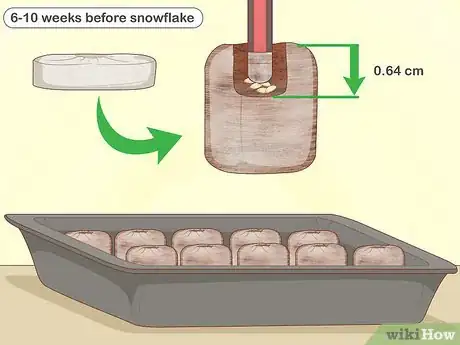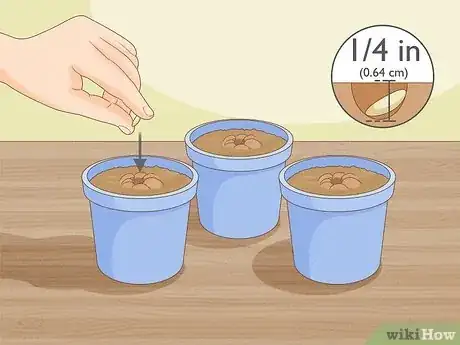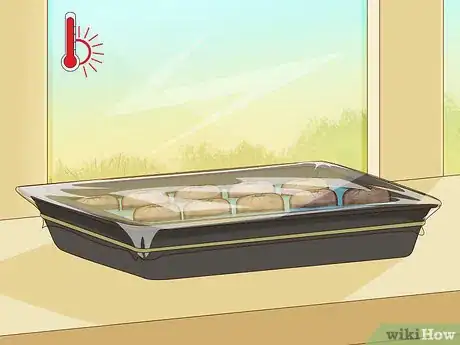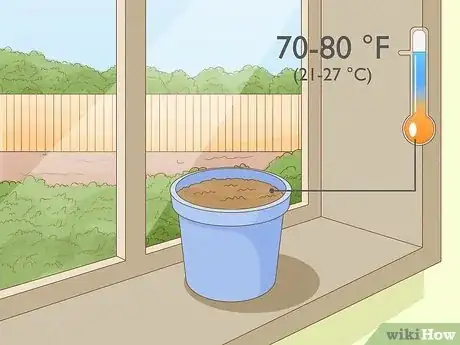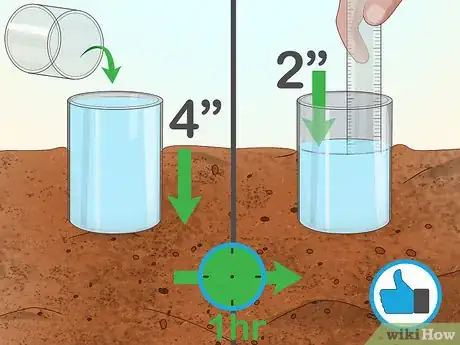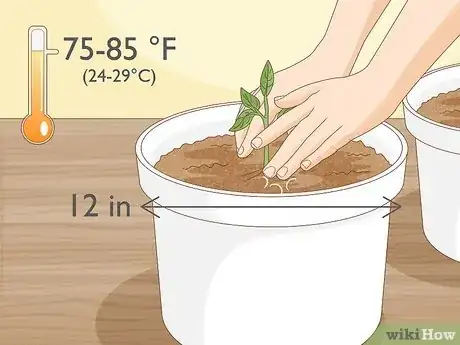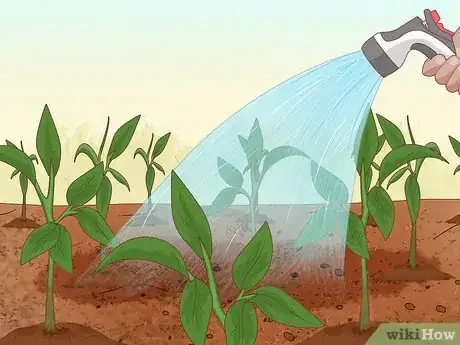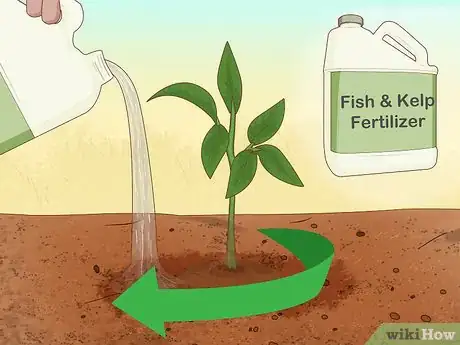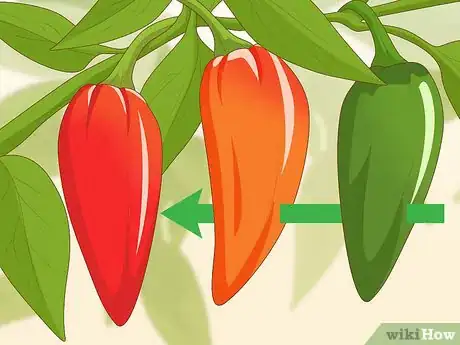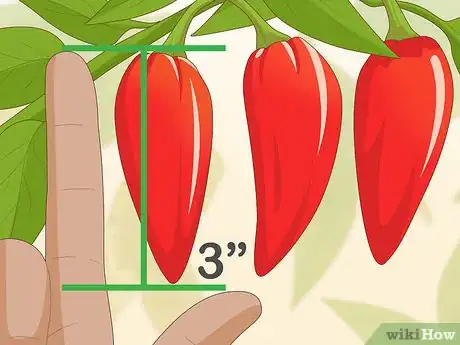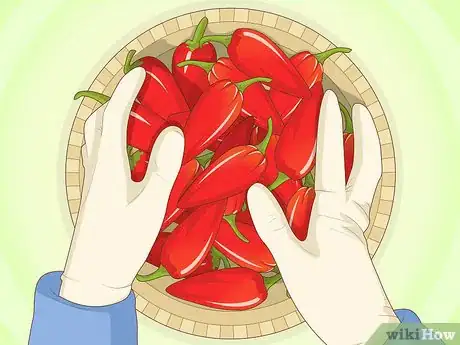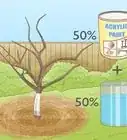This article was co-authored by Maggie Moran and by wikiHow staff writer, Hannah Madden. Maggie Moran is a Professional Gardener in Pennsylvania.
There are 7 references cited in this article, which can be found at the bottom of the page.
This article has been viewed 66,365 times.
Want to add some spice to your garden (literally)? Ghost peppers have a Scoville rating of over 1 million, which is about 400 times hotter than a jalapeno. These tasty peppers are easy to grow, especially if you live in a warm, humid climate. In this article, we’ll share everything you need to know about growing ghost peppers, including starting them from seed, transplanting them outdoors, and harvesting.
Things You Should Know
- Start ghost peppers indoors in late winter or early spring.
- Move the peppers outdoors after 1 month. Pick a sunny, well-draining location that stays warm.
- Water the peppers daily, and fertilize them once they start bearing fruit.
- Harvest the peppers once they turn red and wrinkly, or after 100 to 150 days.
Steps
Starting Seeds Indoors
-
1Plant the seeds indoors 1 to 2 months before the final frost date. Ghost peppers don’t do well in cold temperatures, so it’s ideal to start them inside. Wait until later winter or early spring to time your peppers perfectly.[1]
- It’s a good idea to start your peppers indoors so you can control the temperature of the soil and the air around them.
- Ghost peppers typically take 14 to 30 days to germinate.
-
2Sow seeds in individual starter pots with potting soil. Fill up a starter pot with potting soil, then bury 1 seed per pot about 1⁄4 in (0.64 cm) down. Cover the seed with soil before moving onto the next pot.[2]Advertisement
-
3Place the seeds in a sunny location for 6 to 8 hours of sun per day. Ghost peppers need a lot of sunlight, even when they’re seedlings. Place your seeds by a windowsill, or use a grow light to give your seeds at least 8 hours of light per day.[3]
-
4Keep the soil temperature between 70 and 80 °F (21 and 27 °C). Peppers prefer warm, humid environments. Check on the soil temperature often to see how warm it is, and turn up the heat in your home if your peppers are too cold.[4]
- If you have a greenhouse, feel free to keep your pepper seedlings in there. The warm, moist conditions of a greenhouse are perfect for growing peppers.
-
5Water the seedlings once a day. Make sure the soil never fully dries out when growing peppers. Check on them once a day, and give them water if they need it.[5]
Moving Plants Outdoors
-
1Transplant your peppers after about 35 days. In a little over a month, you’ll notice that your seedlings have grown sprouts that are about 3 to 4 in (7.6 to 10.2 cm) tall. Once that happens, it’s time to move them from their starting pots to their final location.[6]
- Ghost peppers do best in warm, humid conditions. If your area is experiencing cold weather or the frost date hasn’t passed yet, keep your peppers inside in pots.
-
2Pick a sunny location with well-draining soil. Ghost peppers don’t like to get stuck in muddy soil. Choose a spot in your garden that’s well-draining and doesn’t have puddles after a rainstorm. Make sure the area gets at least 8 hours of sunlight per day to help the peppers grow.[7]
-
3Test for soil with a pH between 6.2 and 7.0. Peppers thrive in this soil, because it’s the perfect balance between neutral and slightly acidic. Test your soil with a soil pH testing kit to find the perfect range for your peppers.[8]
- If your soil pH is too low, adjust it by adding pulverized lime to your soil.
- If the pH is too high, decrease it by adding organic materials like pine needles or compost.
-
4Space the plants 18 to 24 in (46 to 61 cm) apart. Give your pepper plants about 1.5 to 2 feet (0.46 to 0.61 m) of space so they have room to grow. Use a spade to dig a hole about 1 in (2.5 cm) deep, then transfer the plants from their containers into the ground. Cover the roots with soil and pat down the area to keep them in place.[9]
-
5Plant in containers if it’s too cold outdoors. If you live in a cold climate, you may be concerned that your peppers won’t thrive. If that’s the case, pick out some pots that are 12 in (30 cm) in diameter and fill them with potting soil. Plant a single sprout into each container, then keep them inside or in a greenhouse for the duration of the growth period.[10]
- Ideally, pepper plants like temperatures 75 to 85 °F (24 to 29 °C).
Caring for Ghost Peppers
-
1Water the peppers daily. Make sure the top 2 in (5.1 cm) of soil doesn’t dry out. Typically, this means you’ll need to water your peppers every day.[11]
- You can test the soil moisture by sticking your finger into the dirt. If the tip of your finger comes out dry, then the soil is dry and needs to be watered. If your finger comes out damp or with soil stuck to it, the soil is wet and doesn’t need to be watered.
- If your area is super dry, add mulch to the ground to help lock in moisture.
-
2Fertilize the peppers when they start fruiting. Use a high-potassium liquid fertilizer to feed the peppers once you notice blossoms. Follow the dilution instructions on the fertilizer, and mix the liquid with water in a watering can. Then, pour the solution near the base of your peppers to give them valuable nutrients.[12]
- Potassium helps plants create new tissue and fruit. The nutrients in high-potassium fertilizer are essential for peppers, and it will help your ghost peppers thrive.
-
3Remove any pests or bugs by hand. Ghost peppers occasionally deal with aphids and larva, but they’re typically easy to manage. Check on your peppers weekly and gently wipe off small insects with water or paper towels. For large insects, pick them off by hand and then kill them.[13]
- If you notice your peppers developing a gray mold near the roots, it could mean that your soil is too moist. Stop watering for a couple of days to see if the mold disappears.[14]
Harvesting Ghost Peppers
-
1Wait 100 to 150 days for your peppers to mature. Ghost peppers typically take 3 to 4 months until they’re ready to eat. While it might be tough, try to be patient—the longer you let the peppers grow, the hotter they’ll be![15]
- During the flowering stage, your peppers will grow small, white flowers that eventually turn into peppers.
-
2Harvest the peppers when they are red and wrinkly. Ghost peppers start out green, then turn a yellowy-orange, and finally end up red in the ripening stage. You’ll know your peppers are ready when they’re bright red and have a slight wrinkle on the skin.[16]
- While you can harvest ghost peppers when they’re green or orange, they won’t be as hot as the red ones.
-
3Wear gloves to protect your hands while harvesting. Ghost peppers are very spicy, and even touching them to your skin can cause mild irritation. If you’re sensitive to ghost peppers and want to save yourself some discomfort, wear gardening gloves as you gently pull the peppers off the plant.[17]
- Always wash your hands after handling ghost peppers, and be careful not to touch your eyes. The capsaicin, or the chemical that creates spice, can transfer from your hands to your eyes, causing severe discomfort.[18]
- Store fresh ghost peppers in your pantry for 2 to 3 days, or keep them in your fridge for 2 to 3 weeks.
Expert Q&A
Did you know you can get premium answers for this article?
Unlock premium answers by supporting wikiHow
-
QuestionHow many peppers does a ghost pepper plant produce per year?
 Maggie MoranMaggie Moran is a Professional Gardener in Pennsylvania.
Maggie MoranMaggie Moran is a Professional Gardener in Pennsylvania.
Home & Garden Specialist
-
QuestionWhat color are ghost peppers when they are ripe?
 Maggie MoranMaggie Moran is a Professional Gardener in Pennsylvania.
Maggie MoranMaggie Moran is a Professional Gardener in Pennsylvania.
Home & Garden Specialist
-
QuestionHow hot is the ghost pepper?
 Maggie MoranMaggie Moran is a Professional Gardener in Pennsylvania.
Maggie MoranMaggie Moran is a Professional Gardener in Pennsylvania.
Home & Garden Specialist
Things You’ll Need
- Ghost pepper seeds
- Starter pots
- Soil pH test kit
- High-potassium liquid fertilizer
- Gardening gloves
- Grow light (optional)
- Plant pots (optional)
References
- ↑ https://www.bountifulgardener.com/when-to-harvest-ghost-peppers/
- ↑ https://ohioline.osu.edu/factsheet/hyg-1618
- ↑ https://totalgardener.com/grow-ghost-peppers/
- ↑ https://ohioline.osu.edu/factsheet/hyg-1618
- ↑ https://totalgardener.com/grow-ghost-peppers/
- ↑ https://www.canna.com.au/ghost_pepper_grow_it_yourself
- ↑ https://ohioline.osu.edu/factsheet/hyg-1618
- ↑ https://ohioline.osu.edu/factsheet/hyg-1618
- ↑ https://ohioline.osu.edu/factsheet/hyg-1618
- ↑ https://www.rhs.org.uk/plants/346586/capsicum-chinense-bhut-jolokia/details
- ↑ https://www.rhs.org.uk/plants/346586/capsicum-chinense-bhut-jolokia/details
- ↑ https://www.rhs.org.uk/plants/346586/capsicum-chinense-bhut-jolokia/details
- ↑ https://ohioline.osu.edu/factsheet/hyg-1618
- ↑ https://www.rhs.org.uk/disease/grey-mould
- ↑ https://totalgardener.com/grow-ghost-peppers/
- ↑ https://ohioline.osu.edu/factsheet/hyg-1618
- ↑ https://www.canna.com.au/ghost_pepper_grow_it_yourself
- ↑ https://ucanr.edu/sites/camasterfoodpreservers/files/337928.pdf
- ↑ https://www.rhs.org.uk/plants/346586/capsicum-chinense-bhut-jolokia/details
About This Article
To grow ghost peppers, you’ll want to start them indoors 6 to 10 weeks before the last frost. First, soak the seeds in a cup of water for at least 8 hours. Then, plant them in peat pods or small seedling containers. Place them in a warm spot like a sunny windowsill and keep the soil moist. When the pods are 3 inches tall, plant them in compost at least 12 inches apart somewhere they’ll get 6 hours of sunlight a day or more. Keep the soil slightly damp but not soaking. You can also mix blood and bone meal or fish and kelp fertilizer into the soil to give your seedlings a nutrients boost. For more tips from our Gardening co-author, including how to harvest your ghost peppers, read on!
